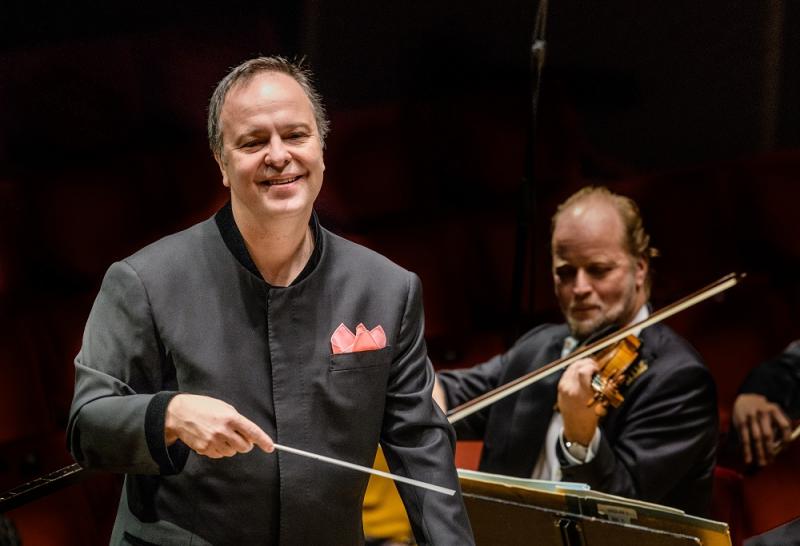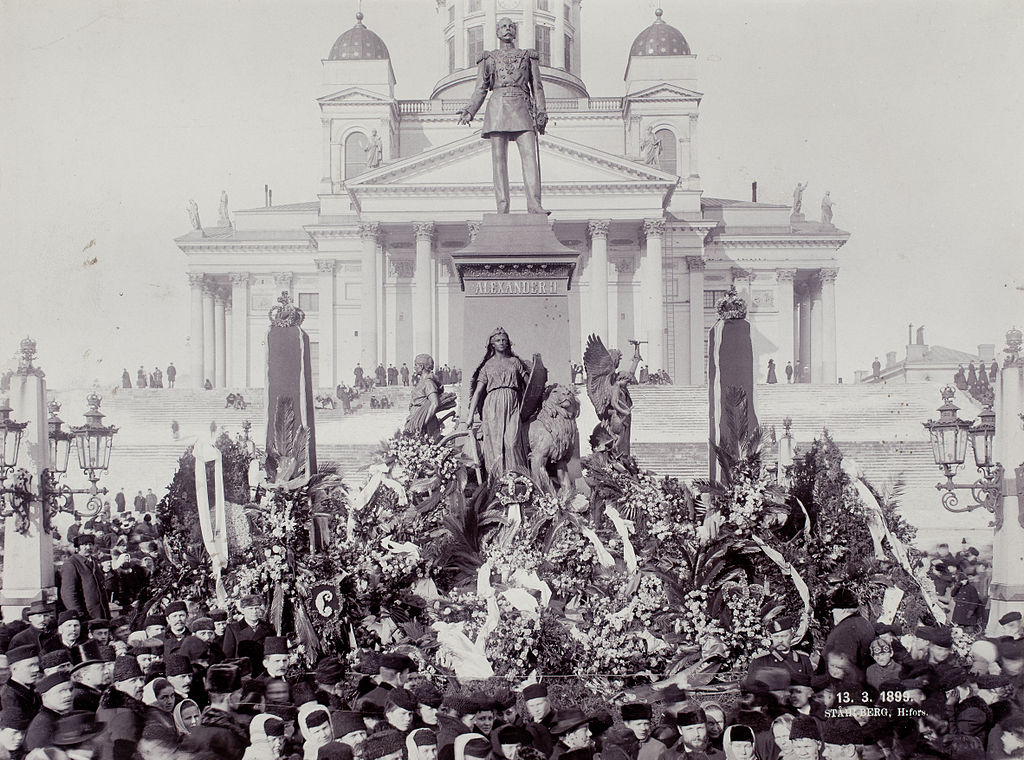Johnston, BBCSO, Oramo, Barbican review - sheer adrenalin in early Sibelius | reviews, news & interviews
Johnston, BBCSO, Oramo, Barbican review - sheer adrenalin in early Sibelius
Johnston, BBCSO, Oramo, Barbican review - sheer adrenalin in early Sibelius
Perfect salute to the Finnish independence centenary includes a vital UK premiere

As the Parliament of the Autonomous Grand Duchy of Finland within the Russian Empire declared independence on 6 December 1917, Sibelius had his head down working on the third version of his Fifth Symphony, the one so hugely popular today.
The background is fascinating, and clearly told in Stephen Johnson's programme note: in short, the Finnish-language press had been closed down in the drive to Russification. The sequence of mythical and historical tableaux for which Sibelius provided such striking music was staged to fund the pensions of those newspaper workers who had been laid off; little did the Russian authorities know how sign and symbol would serve as patriotic flares. Three of the seven numbers Sibelius reworked as the first set of Scènes historiques, rescored but in both versions teeming with invention; Oramo encouraged the ever more refulgent BBCSO strings to show off the depth of their passionate sweep in the European dance-culture of Duke John of Turku's renaissance court, while the brass fanfares bursting out of the proud wind in the Prelude and across the bassoons' lugubriousness for "The Finns in the Thirty Years War" carried an electric charge, like so much in the evening (pictured below: Helsinki citizens in March 1899 protest against the new drive to Russification by laying flowers beneath the statue of 'good' Tsar Alexander II). . More climactic still, the last of the six scenes is what we know as Finlandia, snarling at the start out of eight mesmerising chords – four for wind, four in harmonically astonishing progression for strings, pianissimo, strictly belonging to the end of "The Great Hostility", the pageant's most daring challenge to Russian autocracy in recalling the 1710 occupation of Viipuri province. Oramo, always a master at connecting movements, gave the continuity a special significance.
More climactic still, the last of the six scenes is what we know as Finlandia, snarling at the start out of eight mesmerising chords – four for wind, four in harmonically astonishing progression for strings, pianissimo, strictly belonging to the end of "The Great Hostility", the pageant's most daring challenge to Russian autocracy in recalling the 1710 occupation of Viipuri province. Oramo, always a master at connecting movements, gave the continuity a special significance.
If only that quiet preface could be kept in future performances of Sibelius's best-known work. It was all familiar sailing, with the beautiful song at its heart moved unsentimentally along, until just before the end, where the big tune blares out in full against Brucknerian welters: were it always done as hair-raisingly as this, I'd plump for the original every time. Curiously, though, there seems to be another, less effective ending, which you can catch in Okko Kamu's Lahti performance of the Press Music on YouTube.
Not even passing familiarity occurred in the two short pieces from 1914-15 after the interval, though you can hear Sibelius's characteristic voice at the heart of Cantique, the first of his Two Serious Melodies, and immediately, in the oscillations of lower strings, in Devotion. Cellist Guy Johnston's full tone easily projected over the thickish scoring; he and Oramo kept Cantique, which could stick in the over-sentimental mire given the wrong treatment, judiciously on the move (Johnston at last night's concert pictured below by Ellis O'Brien).  Then it was back to the reckless early SIbelius, teeming with inspiration, in the First Symphony. Having offered us ideal poise in the two leanest symphonies, the Fourth and Sixth, in the previous instalment of the cycle, Oramo went for broke in the hurtling challenges of Sibelius's belated musical adolescence. It was all beautifully modulated beneath the surface, though; while second violins shimmered their souls out to welcome the main idea of the first movement, the ardent melodising had emotional space at just the right points; no conductor manages luftpausen, discreet stops for breath, finer than Oramo, and none is better at keeping the tension over the longer silences, the abyss, between the sounds. Hugely impactful contributions, too, from BBCSO soloists, led by Daniel Pailthorpe and Tomoko Mukai in an ear-tingling flute duet and subtle harp work from Louise Martin (when have you ever heard the instrument have the last, reverberating word at the end of the first movement before?)
Then it was back to the reckless early SIbelius, teeming with inspiration, in the First Symphony. Having offered us ideal poise in the two leanest symphonies, the Fourth and Sixth, in the previous instalment of the cycle, Oramo went for broke in the hurtling challenges of Sibelius's belated musical adolescence. It was all beautifully modulated beneath the surface, though; while second violins shimmered their souls out to welcome the main idea of the first movement, the ardent melodising had emotional space at just the right points; no conductor manages luftpausen, discreet stops for breath, finer than Oramo, and none is better at keeping the tension over the longer silences, the abyss, between the sounds. Hugely impactful contributions, too, from BBCSO soloists, led by Daniel Pailthorpe and Tomoko Mukai in an ear-tingling flute duet and subtle harp work from Louise Martin (when have you ever heard the instrument have the last, reverberating word at the end of the first movement before?)
It might be overkill, but how welcome a concert from this team twinning Sibelius's First with Mahler's might be. The interpretation reminded one how the playing can never be too roughly vigorous in Sibelius's scherzo, as in Mahler's, and both finales begin with what Mahler called "the cry of a deeply wounded heart". If this endgame doesn't go as deep as the composer clearly wanted it to – the best a performance can do is to hold the tension as it falls apart, and the central turbulence here was stupendous – I never had tears in my eyes during the big tune before.
I've heard from the BBC players that Oramo is the only principal conductor they've ever had for whom adoration is unanimous, and when you hear heart and soul so magisterially focused as it has been throughout this series so far – there's one more to go, in January – you have to believe it. One final burst of applause for Oramo's succinct and perfect spoken introduction: he managed to reference the brevity of 100 years, from his grandparents as Russian subjects to himself as a second-generation citizen of independent Finland, great Finnish men and strong Finnish women in the arts (three examples of each), and the hope that his country would embrace "wider views and bolder visions" given the troubles we face today. Quite a Mensch.
rating
Share this article
The future of Arts Journalism
You can stop theartsdesk.com closing!
We urgently need financing to survive. Our fundraising drive has thus far raised £49,000 but we need to reach £100,000 or we will be forced to close. Please contribute here: https://gofund.me/c3f6033d
And if you can forward this information to anyone who might assist, we’d be grateful.

Subscribe to theartsdesk.com
Thank you for continuing to read our work on theartsdesk.com. For unlimited access to every article in its entirety, including our archive of more than 15,000 pieces, we're asking for £5 per month or £40 per year. We feel it's a very good deal, and hope you do too.
To take a subscription now simply click here.
And if you're looking for that extra gift for a friend or family member, why not treat them to a theartsdesk.com gift subscription?
more Classical music
 Bizet in 150th anniversary year: rich and rare French offerings from Palazzetto Bru Zane
Specialists in French romantic music unveil a treasure trove both live and on disc
Bizet in 150th anniversary year: rich and rare French offerings from Palazzetto Bru Zane
Specialists in French romantic music unveil a treasure trove both live and on disc
 Scottish Chamber Orchestra, Ibragimova, Queen’s Hall, Edinburgh review - rarities, novelties and drumrolls
A pity the SCO didn't pick a better showcase for a shining guest artist
Scottish Chamber Orchestra, Ibragimova, Queen’s Hall, Edinburgh review - rarities, novelties and drumrolls
A pity the SCO didn't pick a better showcase for a shining guest artist
 Kilsby, Parkes, Sinfonia of London, Wilson, Barbican review - string things zing and sing in expert hands
British masterpieces for strings plus other-worldly tenor and horn - and a muscular rarity
Kilsby, Parkes, Sinfonia of London, Wilson, Barbican review - string things zing and sing in expert hands
British masterpieces for strings plus other-worldly tenor and horn - and a muscular rarity
 From Historical to Hip-Hop, Classically Black Music Festival, Kings Place review - a cluster of impressive stars for the future
From quasi-Mozartian elegance to the gritty humour of a kitchen inspection
From Historical to Hip-Hop, Classically Black Music Festival, Kings Place review - a cluster of impressive stars for the future
From quasi-Mozartian elegance to the gritty humour of a kitchen inspection
 Shibe, LSO, Adès, Barbican review - gaudy and glorious new music alongside serene Sibelius
Adès’s passion makes persuasive case for the music he loves, both new and old
Shibe, LSO, Adès, Barbican review - gaudy and glorious new music alongside serene Sibelius
Adès’s passion makes persuasive case for the music he loves, both new and old
 Anja Mittermüller, Richard Fu, Wigmore Hall review - a glorious hall debut
The Austrian mezzo shines - at the age of 22
Anja Mittermüller, Richard Fu, Wigmore Hall review - a glorious hall debut
The Austrian mezzo shines - at the age of 22
 First Person: clarinettist Oliver Pashley on the new horizons of The Hermes Experiment's latest album
Compositions by members of this unusual quartet feature for the first time
First Person: clarinettist Oliver Pashley on the new horizons of The Hermes Experiment's latest album
Compositions by members of this unusual quartet feature for the first time
 Gesualdo Passione, Les Arts Florissants, Amala Dior Company, Barbican review - inspired collaboration excavates the music's humanity
At times it was like watching an anarchic religious procession
Gesualdo Passione, Les Arts Florissants, Amala Dior Company, Barbican review - inspired collaboration excavates the music's humanity
At times it was like watching an anarchic religious procession
 Classical CDs: Camels, concrete and cabaret
An influential American composer's 90th birthday box, plus British piano concertos and a father-and-son duo
Classical CDs: Camels, concrete and cabaret
An influential American composer's 90th birthday box, plus British piano concertos and a father-and-son duo
 Cockerham, Manchester Camerata, Sheen, Martin Harris Centre, Manchester review - re-enacting the dawn of modernism
Two UK premieres added to three miniatures from a seminal event of January 1914
Cockerham, Manchester Camerata, Sheen, Martin Harris Centre, Manchester review - re-enacting the dawn of modernism
Two UK premieres added to three miniatures from a seminal event of January 1914
 Kempf, Brno Philharmonic, Davies, Bridgewater Hall, Manchester review - European tradition meets American jazz
Bouncing Czechs enjoy their Gershwin and Brubeck alongside Janáček and Dvořák
Kempf, Brno Philharmonic, Davies, Bridgewater Hall, Manchester review - European tradition meets American jazz
Bouncing Czechs enjoy their Gershwin and Brubeck alongside Janáček and Dvořák
 Solomon, OAE, Butt, QEH review - daft Biblical whitewashing with great choruses
Even a top soprano and mezzo can’t make this Handel paean wholly convincing
Solomon, OAE, Butt, QEH review - daft Biblical whitewashing with great choruses
Even a top soprano and mezzo can’t make this Handel paean wholly convincing

Add comment